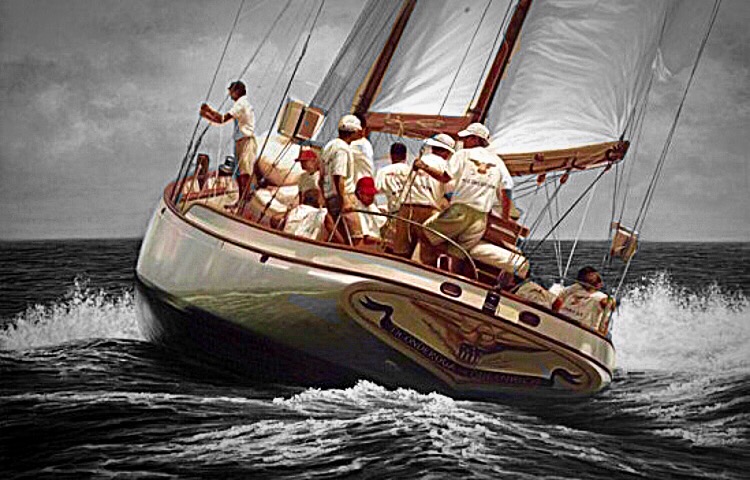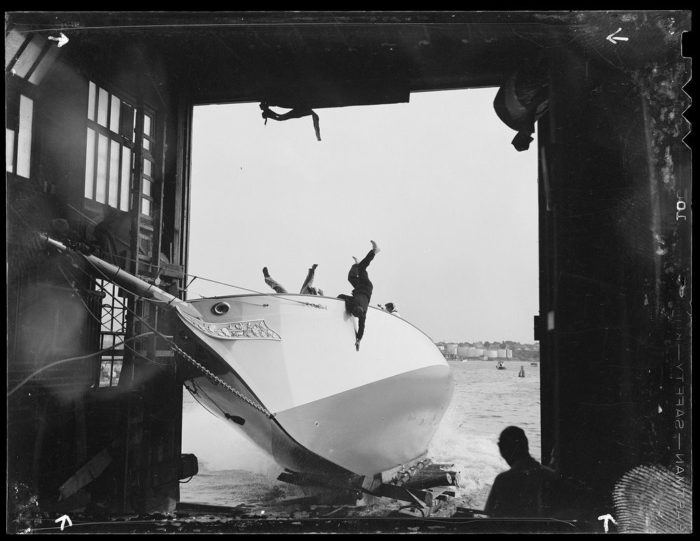
Sail Number: 100
Type: Ketch
LOA: – LOD: 71’11” / 21.92m – LWL: 65′10″ / 20.06m – Beam: 16′ 0″ / 4.87m – Draft: 7′ 9″ / 2.36m – Displacement: 108,288 lbs – Ballast 30,750 lbs – Sail Area: 2,897 sq ft – Design Number: 66 – Designer: L.F. Herreshoff – Built by: Quincy Adams YT, YD, Inc, Quincy, Ma – Year Built: 1936 – Original Owner Harry Noyes. – Engine: Detroit 4-53 – hp 128 – Location: Marine Traffic – Flag: USA (US)
Historical
A legendary classic sailboat designed by L. Francis Herreshoff for the intrepid yachtsman Harry Noyes, the 72-foot, clipper-bowed ketch was originally named Tioga II of Marblehead. Her second owner bought the boat, but not the name, and while doodling with pencil emblazoned with the brand name Ticonderoga, he saw the answer that kept intact both the letters and the intent of her original name. Over the decades there’s been a series of owners, each with a story all their own — some wore her down, others bestowed lavished refits.
L. Francis Herreshoff was the son of yacht designer Nat Herreshoff, often called “The Wizard of Bristol,” L. Francis, however, was an independent thinker. He demonstrated his independence by setting up shop in the design office of Burgess, Swasey & Paine, a gifted group of Boston naval architects, and arch competitors of his father.

Starling Burgess took the young Herreshoff under his wing and was certainly instrumental in his early career. The firm’s awareness of materials and structures as well as fair hull shapes helped L. Francis develop a keen eye for both grace and seaworthiness. Preceding Tioga of Marblehead, on Herreshoff’s drawing board was a ketch named Joann (eventually renamed Brigadoon), and the Tioga of Boston. Both boats were designed and built for Waldo Brown. It was Tioga of Boston that caught Harry Noyes’ attention, and before long he convinced Brown to sell him the ketch. After only one season he went directly to Herreshoff for a bigger, faster rendition of the 57-foot ketch, and an evolution in yacht design would yield revolutionary results.
Designed in a year, building began in 1936 at the Quincy Adams Yacht Yard in Massachusetts. Tioga of Marblehead was designed with performance in mind but rating rules had been ignored. Harry Noyes, a man of means, owned larger vessels for cruising purposes, and meter boats to satisfy his racing whims. Tioga was initially conceived as a family day sailer. As with all custom boat building projects, the art lay in the owner/client pas de deux, which, in this case, would prove to be more than a complex duet.
The building process was complicated by the fact that Noyes was both Herreshoff’s client, and the owner of the shipyard that would build the boat. Changes from the design, no matter how small, became major issues of contention — to the point where Herreshoff chose not to attend or was not invited to the launching. At one point, he was queried as to why there was such modest headroom and his response was quite straightforward. “The boat’s a day sailer, not a goddamned dance hall!”
The post-Depression era at the Quincy Adams Yacht Yard was a time when craftsmen were glad to have work, and they plied their skills as artisans rather than as assembly-line workers. Ti’s scantlings were lighter than the more crudely built vessels of the day, but her backbone was made of good Yankee white oak, and her planks of carefully chosen, bronze-fastened tropical mahogany. The Port Orford cedar decking would prove to be an inferior choice, and her new fangled hollow Sitka spruce spars would be too flexible. An extra layer of spruce would eventually be added at the Luders yacht yard in Stamford, Conn.
A big mistake was averted during the building process when the yard foreman insisted on keel bolts with nuts at both ends. Herreshoff’s design called for heavy lag bolts to be screwed into the antimony-treated lead. This procedure would soon fall out of favor due to the nasty habit of ballast keels pulling away from such a lag bolt attachment.
The day of the big event drew a crowd to the Quincy yard and just as the regal ketch began to slide down the tallow-slick ways, a gunshot-like crack signaled the collapse of the bracing. As Tioga of Marblehead began to exit the shed she rolled onto her side, hitting the water and unleashing 30,000 pounds of external lead and a force that brought the big ketch abruptly back onto her feet. Three crewmembers flew from one side of the foredeck to the other — whip-lashed by the boat’s substantial righting movement. The awe struck crowd were of two opinions — either this would be a very special boat, or bad omens were already at play.
As with most new boats, perfection may have been the target, but the mark did, in some ways, fall a little short. Most noticeable was the fact that Big Ti sat quite low on her lines, mostly due to what had been added during the building process, usually under designer protest. What started out as a large but simple day sailer, had shouldered the extra weight of a generator, bronze radiators and boiler-fired heating system, a large refrigerator and deep freeze, two showers, and a cast iron bathtub, along with large tanks for water and fuel.
Despite these few shortfalls, the big ketch proved herself more than a decent day sailer, and before long Noyes and a long list of subsequent owners were planning for the next ocean race she would enter — and more often than not, finish in-the-money. Line honors and course records began to stack up in 1936, and 30 years later, Ti was still at it — setting the record for the Los Angeles to Honolulu Race. In between, she carved tracks in the ocean between Tahiti and Copenhagen, not just arriving at those landfalls but setting course records for offshore races. Her long waterline and split rig made her a reaching machine and despite her low freeboard, a very seakindly sailboat.
Decades of being driven hard and put away wet takes a toll on any vessel, and Ti’s first crucial refit came after she took on a coat of gray paint and did her service in World War II. Years of patrol duty off the East Coast turned a fine yacht into a worn out work boat — and with her return to civilian life came the ongoing challenge of keeping an aging yacht fit for sea.
![]()
Perhaps Ti’s best patron was owner Bob Voit who shouldered a full restoration done at Southampton Yacht Services in England in 1988. The refit estimate was twice what he had paid for the vessel, and included 90 new frames and replanking from the waterline up. Below the waterline the planking had been done by Spencer’s yard in Florida some years before. The deck beams and decks were also to be replaced and a new Munford interior was painstakingly fitted. New systems were also added to the list, and the bottom line rolled in at over $900,000, a bargain in today’s rates.
Tom Reardon, Ti’s pro skipper for the last 21 years, points to a few key factors done during this refit that have really helped the boat to stand up to the test of time. The first was prompted by the industry’s wise avoidance of white lead, a product that worked well between layers of double-planked hulls, but not in the humans who handled the toxic substance. In lieu of the lead, the yard chose a new polyurethane sealant called 5200, manufactured by 3M. The crew slathered on this miracle whip, coating the space between the double-planked hull. Its rugged adhesive quality and its elasticity proved to be the perfect product for the job. Another wise decision was to build a one-inch thick Bruynzeel plywood sub-deck, and then glue rather than mechanically fasten one-inch teak on top. The rock solid results have kept the deck and hull from working, and today the boat is still going strong thanks to that 1988 restoration.
Just as Bob Voit proved to be a true benefactor and aid to Ticonderoga’s longevity, her current owner, Scott Frantz, also sees the big ketch as a floating national treasure. He has worked hard to keep this classic yacht thriving in her golden years. During his ownership he’s cruised Ti in the Mediterranean, raced her in the Caribbean and done Down East club cruises in New England. Swapping seasons between the tropics and New England, Ticonderoga is based out of Antigua in the winter and home-ported in Greenwich, Conn., during the summer.
Short-handed passagemaking has been facilitated by Ti’s split rig and fairly low aspect ratio sail plan. There are no furling headsails or in-spar reefing systems, simply conventional piston hanking jibs set on the foredeck under sail covers. Each is hanked to an individual stay and ready to be hoisted. The mainsail is more than 1,200 square feet, but Reardon points out that he can sail locally “with a crew of three and me,” and ups the team by two when making a passage to or from the Caribbean.
Ticonderoga is a living legend that’s still going strong, and her story is replete with the lure of the sea, the feel of a wooden hull and the tales of the characters who have kept her on course.
Provenance (The Wall of Remembrance – The Owners, Crew & Notable Guest):
Owner/Guardian: (1936) – Harry Noyes, Marblehead, Mass.
Owner/Guardian: (1942) – War service, U.S. Coast Guard (submarine patrol)
Owner/Guardian: Allen Pinkerton Carlisle and John Hertz Jr., father founded Hertz Rent-A-Car.
Owner/Guardian: (1963) – Robert Johnson, Oregonian lumberman purchased vessel for $50,000 (vessel became known as Big Ti, transformed into a famous ocean racer.
Owner/Guardian: (1971) – Ken & Fran MacKenzie
Owner/Guardian: Bob Voit
Captain: Tom Reardon
Deckhand: Johan Bouvin
Deckhand: Curtis Barton
Owner/Guardian: (1993) – Scott and Icy Frantz

Hello,
As the son of Bradley Noyes, the youngest son of Harry Noyes, I grew up with many firsthand stories about my grandfathers boat. Anyhow the big Tioga was just “Tioga” not Tioga II. That was a smaller version.
It’s fun to see her still!
Thanks